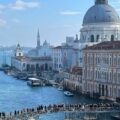“From the Romantics to Segantini” is the title of the splendid exhibition organized by the Linea d’Ombra association at the Centro San Gaetano in Padova and open until the 5th of June.
Sixty-five works, between the 19th and 20th centuries, personally chosen by curator Marco Goldin from the Oskar Reinhart Foundation, creating an exceptional exhibition never seen before in Italy.
Stories of moons and then of gazes and mountains: a fascinating journey through Europe through the paintings of romantic painter-travelers, including landscapes and portraits.
Romanticism is a cultural movement that originated in Germany in the 19th century and then spread to most of Europe. It mainly concerned painting, although repercussions could be found in music, architecture and literature.
Although each country has its own particularities and different facets, the basic characteristic of this artistic movement is undoubtedly the imagination and subjective expression, the relationship between man and nature, which is manifested by triggering conflicting feelings in man and giving access to the inner self and mystery. Nature is interpreted as the manifestation of God on earth and for this reason, in these centuries, a strong need for faith and spirituality returns.
The themes we find most frequently are nature, scenes from national history, ancient fairy tales or particularly dramatic tales.
Romantic painting…
…in ENGLAND finds as its greatest exponents: William Blake, a visionary obsessed with original sin; William Turner, who prefers to depict nature and landscape with a particular attention to light and atmosphere to the point of making forms lose their consistency, and John Constable, who instead tries to represent as faithfully as possible what he sees, without seeking ennobling effects and enhancing the most humble details.
…in GERMANY the greatest interpreter is certainly Caspar David Friedrich who follows a more philosophical and religious orientation. Landscapes that express melancholy and solitude, the existential anguish of man in his paintings is found in front of the infinite and an arcane and symbolic nature.
…in FRANCE we find depictions of contemporary national history in the paintings of Théodore Géricault and Eugène Delacroix that carry the metaphor of the despair of human life and allegorical representations of important feelings for the people.
…in ITALY it finds its greatest expression in Venice thanks to Francesco Hayez, a well-known portrait painter who interpreted history painting in his own way, using it as a means of conveying facts from the past, taking particular inspiration from the Italian Middle Ages.
…in SPAIN the greatest exponent was Francisco Goya, a man who was very involved in the political life of his time and very close to the liberals. He denounced the brutality of those years with a painting rich in pathos, thanks above all to the combination of colours.
We look forward to seeing you at the AbanoRitz to combine business with pleasure and to immerse yourself in the thermal and cultural well-being of an area that has everything to offer.











